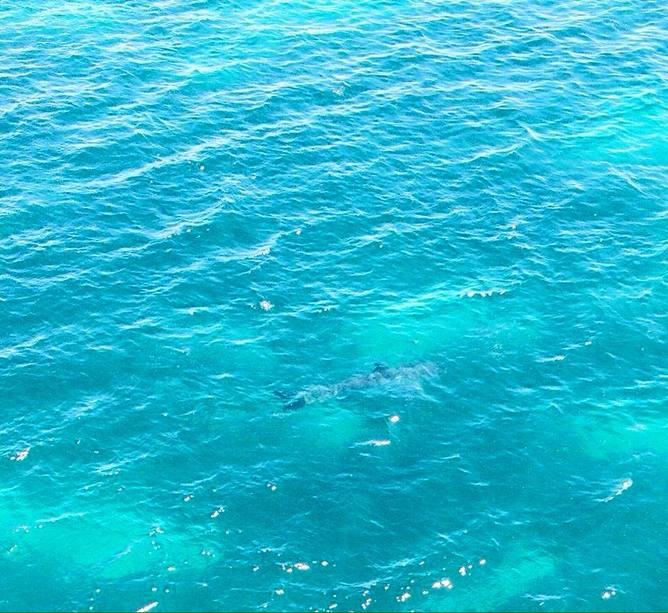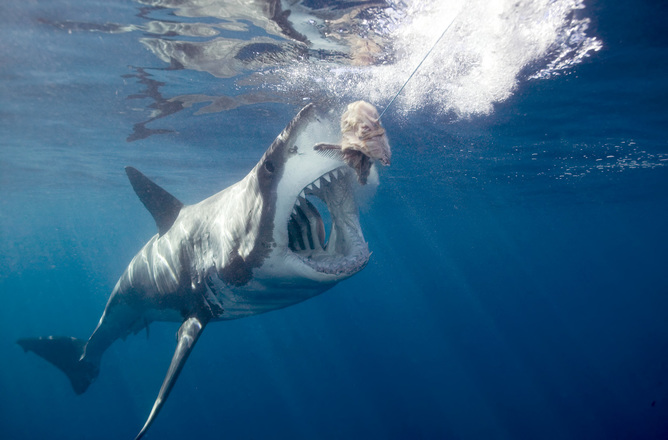There's Science Behind that 'Jaws' Sighting (Op-Ed)


This article was originally published at The Conversation.The publication contributed the article to Live Science's Expert Voices: Op-Ed & Insights.
It was, by any measure, a giant. On January 17, patrol helicopters off the coast of southern Australia reported seeing a great white shark “nearly as big as Jaws”. In fact, it was estimated to be up to 23ft long, only marginally smaller than the infamous movie killer – and it came to within just 100 metres of the shore. Perhaps unsurprisingly, the connotations with Peter Benchley’s 1974 novel sent the internet into its usual frenzied panic when such a “monster” is spotted.
Last summer, videos of what many believe to be the largest white shark ever caught on film also sent the internet into meltdown. These large sharks will always make headlines, but instead of igniting fear, they should be cause for celebration.
In recent years, many sharks – including the great white – have been severely reduced in numbers, with some species down by 90%. While calculating the precise numbers of individuals is difficult, there are promising signs that some white shark populations are now on the rebound. This is in part due to measures put in place to protect both the sharks and their main prey, marine mammals.
The sharks have either been killed by targeted commercial fishing for their fins and meat, or accidentally caught in other fisheries. Elsewhere, they are hunted for trophies, grandstanding profile pictures or because they are seen as a threat to humans. It has been estimated that between 63m and 273m sharks could be killed every year by fishing. Populations have reached such low numbers in places that some species now are at a high risk of extinction.
Which makes the latest sighting very special indeed. At a time when many species are struggling, such a large shark is a rare sight.
So how big was it?
There is a famous tendency to exaggerate the size of fish – and sharks, in particular. The referenceless of the ocean can make judging distances and length difficult and with no solid means to verify the size of this shark, we can’t say for sure that it really was seven metres long. While coast guards reported that the shark was bigger than their six-metre jet boat, it is hard to extract any biologically relevant information from the fleeting sighting other than it was a big shark doing what sharks do.
Get the world’s most fascinating discoveries delivered straight to your inbox.
What we can say, however, is that large great white sharks are usually the old ones. And they can get really quite old. In fact, a recent study found that white sharks might live as long as 70 years. These older sharks are great for the population, because they have had ample opportunity to reproduce, introducing offspring into a dwindling population.
But in all the Jaws-style fanfare, it’s important to look also at how the local community has dealt with the sighting. In many places around the world, just as in the film Jaws, we might have seen a large-scale hunt undertaken to capture the “man-eating” monster and stop it from killing on their beaches.
The hunted hunter
Indeed, Western Australia recently controversially lifted the protective status of great white sharks and implemented a shark cull along its coast in an attempt to boost tourism after a spate of fatal shark incidents. But the programme came under huge criticism for failing to capture a single white shark and killing many other species not involved in recent fatalities.
Destroying sharks to increase beach safety has been widely criticised by the scientific community due to the huge impact that these methods can have on many aspects of the ecosystem. In the past, countless technologies and protocols were developed to reduce the number of fatalities from shark incidents, but with no unifying answer.
But the latest sighting offers fresh hope. What we have here is a community that is learning to share the ocean with these important ocean predators. Shark Alerts South Australia (SASA), the Facebook page where the initial sighting was shared, is emblematic of a community accepting the beauty and significance of the great white.
Following the sighting, local ocean events were cancelled and “shark sirens” were sounded. But while ocean users exited the waters, helicopters and boats were deployed not to kill, but to herd “the large white shark out to sea”. All the while SASA were sharing the information with its 55,000+ followers.
The community driven Facebook page is updated regularly and allows potential users to think twice before entering potentially dangerous situations. Last year they reported about 170 to 180 sightings, but as their followers continue to increase, so will their reports. This is a great example of how social media and advances in technology can help reduce the number of incidents, while educating people at the same time.
Age of the technoshark
In Western Australia, tagged sharks are now “using” Twitter to alert ocean users to their presence near local beaches. And in the scientific world, new technologies and autonomous underwater drones are being used to observe previously unseen habitats, feeding ecology and behaviors in great white sharks.
It has been found that many ocean users in Australia often encounter sharks, without harm, and support further research and education. These are all promising signs that we are moving away from the barbaric approaches to mitigating shark incidents. Instead, communities are learning to share the ocean with sharks, even profiting from tourism industries set up specifically to see them.
Sharks are hugely important for maintaining the balance and health of our ecosystems. Learning to live alongside them will be challenging and we still have a long way to go. But with changing perceptions and advances in technology, a peaceful coexistence with “Jaws” may be closer than you think.
Christopher Bird, Ph.D student: Shark Ecology, University of Southampton
This article was originally published on The Conversation. Read the original article. Follow all of the Expert Voices issues and debates — and become part of the discussion — on Facebook, Twitter and Google +. The views expressed are those of the author and do not necessarily reflect the views of the publisher. This version of the article was originally published on Live Science.






